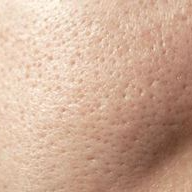It’s important to identify yourpersonal skin type before choosing your products.
What Skin do I have?Skin types and conditions
Use the following explanation to ensure a perfect match and to properly care for your skin.
SKIN TYPES
Normal skin
well-balanced skin that has fine pores, good blood circulation, a velvety, soft and smooth texture, no blemishes and a rosy uniform color. Can be improved with the use of topical skin care treatments.
Dry skin
A skin type that produces less sebum than normal skin. Can feel tight, lack of moisture, brittle and rough and look dull, mild scaling or flakiness in patches, possible itchiness. Skin elasticity is also low. Can be improved with the use of topical skin care treatments.
Oily Skin
A skin type with over production of sebum. Has enlarged visible pores, glossy shine look, thicker. Oily skin is prone to comedones (blackheads and whiteheads) and to the varying forms of acne.
Can be improved and normalize with the use of topical skin care treatments.
Combination Skin
Oily in the T-zone (forehead, chin and nose)
enlarged pores in this area perhaps with some impurities normal to dry cheeks. Can be improved with the use of topical skin care treatments.
Sensitive Skin
Your skin has fine pores, can be easily irritated and is prone to redness. Sensitive skin is often genetic and can also react to poor diet, changes in weather, hormonal imbalance and certain cosmetic products. Sensitive skin must be treated with the correct skin care products that are gentle and soothing to heal your skin and relieve your symptoms.
SKIN CONDITIONS
The many internal and external factors that determine its condition include: climate and pollution, medication, stress, hereditary factors that influence the levels of sebum, sweat and natural moisturizing factors that your skin produces as well as the products that you use and the skincare choices that you make. The right treatment with natural active herbal ingredients can produce amazing results.
Ageing
Skin aging is chad rough-textured appearance.
Two factors that characterize by wrinkling, loss of elasticity, laxity, cost ageing:
Intrinsic aging is an inevitable physiological process that results in thin, dry skin, fine wrinkles, and gradual dermal atrophy.
extrinsic aging is engendered by external environment factors such as air pollution, smoking, poor nutrition, poor hydration and sun exposure.
Dehydrated
All skin can become dehydrated. Luckily, dehydrated skin is temporary and can be relieved with a combination of topical treatments and lifestyle changes.
four signs of dehydrated skin:
Itchy Skin, Increased Sensitivity, Dull Skin, Fine Lines & Wrinkles.
Rosacea - Inflammation and Redness
The condition on Rosacea skin is characterized for inflammation and reddening on the nose, forehead, cheekbone or chin. Inflamed capillaries on the skin’s surface give the complexion a red, blotchy or bumpy appearance. Rosacea is usually a genetic condition, but certain factors are known to aggravate it. Avoiding hot liquids, alcohol, the sun and extreme temperatures plus using products designed to help calm skin will help to clear irritations and control redness.
Loss of Firmness
Just like muscles throughout the body, the muscles under the surface of the complexion can lose tone. This can happen at any age like 20 or 30 and is call premature aging. The principal reason are: sun exposure, lifestyle and nutrition, the skin then appears to sag. Dehydrated skin can also appear to droop around the eyes and jawline. A consistent, targeted skin care regimen and regular facial are key ways to keep skin healthy and firm.
Sensitivity
Is skin that is easily irritated and is more reactive than normal skin. Identifying and evaluating symptoms such as redness, a rash, stinging, itching and burning help in determining skin condition.
Acne - Breakout Prone
Acne can affect skin at any age from adolescent to adult. Acne is usually characterized by oily to normal skin that persistently breaks out, is clogged, reactive and is sometimes inflamed.




